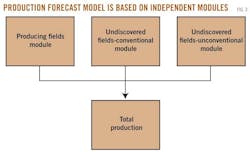P. 2 ~ Continued - How Haynesville shale will lift Louisiana's gas production profile
View Article as Single page
Resource categorization
Field definition
A field is defined as the surface area directly above one or more producing reservoirs all related to the same geologic structural feature and-or stratigraphic condition.
The Louisiana Office of Conservation reviews producing leases and production information submitted by operators, logs, geophysical records, and other data to establish the existence of a new field or the extension of an existing field.5 In Louisiana, fields are described in terms of lease unit well (LUW) administrative codes.
Development status
Oil and gas resources are divided into three categories according to development status and project maturity: producing fields, discovered undeveloped fields, and undiscovered fields.
Producing fields are fields that produce any amount of oil or gas in the year of analysis. Producing fields are "hard" assets because they have been developed through capital investment; their physical existence is established; and reserves are believed to be known to a reasonable degree of certainty.
Undiscovered fields are those fields that are expected to be discovered and produced in the future. The existence of undiscovered fields is speculative and depends upon geologic prospectivity, capital investment, technology development, and various other factors. Typically, a regional assessment is performed to determine potential, and with a discovery model future production is assessed. Discovery models range from the simple to complex and attempt, based on statistical outcomes and geologic conditions, to reflect the uncertainty of future production pathways.
Discovered undeveloped fields lie between producing fields and undiscovered fields. Most are discoveries that have been announced or known to exist but are not currently producing. Undeveloped reserves are those reserves of any category that are expected to be recovered from new wells on undrilled average, or from existing wells where a major expenditure is required for recompletion.
Discovered undeveloped fields require major investment to produce and are categorized separately from proved developed producing reserves. A common example of undeveloped fields are those reserves that underlie undrilled portions of a property adjacent to current producers and are, based on engineering and geological evaluation, reasonably likely to produce hydrocarbons.
Some areas of the US such as offshore California, Alaska, and the Eastern Gulf of Mexico have significant discovered undeveloped fields but because of regulatory constraints and-or public opposition, drilling is not permitted. Louisiana is a mature petroleum region and the inventory of undeveloped fields is expected to be small.
Technology status
A conventional field is a discrete accumulation or set of accumulations that are bounded by a downdip water contact from which hydrocarbons in liquid or gaseous forms are extracted. Unconventional reservoir systems are often synonymous with "continuous" accumulations and include tight gas sands, shale gas, shale oil, and coalbed methane reservoirs.
Unconventional fields are more expensive to develop than conventional fields and are more difficult to characterize, and require novel or new technologies to produce. Once market penetration exceeds a certain threshold and cost/risk decline and are "comparable" to other technologies, the demarcation between "unconventional" and "conventional" becomes less clear.
Product type
Fields are classified as oil or gas fields based on the volume of produced gas (measured in cubic feet) per unit of produced oil (measured in barrels) and described through the gas-oil ratio (GOR).
Cumulative GOR (CGOR) is the aggregate oil and gas production ratio at the time of evaluation. A field with cumulative gas-oil ratio CGOR < 5,000 cu ft/bbl is labeled an oil field and a field with CGOR > 5,000 cu ft/bbl corresponds to a gas field.
Production forecast modules
Oil and gas production is modeled using three independent modules as shown in Fig. 3. State production arises from the contribution of existing assets (producing fields) and new fields (conventional and unconventional) that are brought into production in the future.
Producing fields include both conventional and unconventional production, while undiscovered fields represent fields that may be discovered and produced in the future. Forecasting future production from producing fields is less uncertain than undiscovered field production, and our choice of models reflects this level of uncertainty.
Undiscovered fields represent production potential and are uncertain in terms of their size, timing, and contribution. Undiscovered conventional fields are modeled using historic discovery rates and the production of analog reservoirs of conventional oil and gas fields. Undiscovered unconventional fields are modeled using a scenario-based approach.
Displaying 2/6
View Article as Single page



